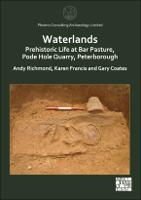Waterlands
: Prehistoric Life at Bar Pasture, Pode Hole Quarry, Peterborough
Author(s)
Richmond, Andy
Contributor(s)
Francis, Karen (editor)
Collection
Knowledge Unlatched (KU)Language
EnglishAbstract
Waterlands: Prehistoric Life at Bar Pasture, Pode Hole Quarry, Peterborough recounts a decade-long archaeological investigation at Bar Pasture Farm, Pode Hole Quarry, Peterborough, and represents one of the most significant landscape excavations carried out in recent years. The 55-hectare archaeological dig was the scene of human activity on the fenland edge from the Mesolithic through to the Late Iron Age, although the majority of the evidence covered the period from the Early Neolithic through to the Middle Bronze Age. Throughout prehistory, the fen edge has represented a landscape at the margins of human habitation and exploitation. During the Early Neolithic, a substantial waterhole complex with signs of later visitation was established on the fen edge. Traces of several Beaker buildings provided elusive evidence of slightly later activity further inland, whilst during the Early Bronze Age proper, a number of impressive burial mounds were constructed within a dedicated ‘Barrow Field’. One barrow contained the nationally significant remains of an infant burial on a birch bark mat with associated grave goods. The Middle Bronze Age saw the entire re-organisation of the surrounding landscape by the creation of an extensive, rectilinear field system, served by multiple droveways and associated with a classic enclosed farmstead. The placement of later Middle Bronze Age cremation burials within the remains of earlier burial monuments bears witness to the intimate connection of this small community to their ancestors’ sacred landscape. By the 4th century BC, settlement was all but abandoned due to marine inundations, although one slightly elevated part of the landscape formed an area of refuge for an Iron Age smith and his family, who created an isolated and significant smithy.
Keywords
Social Science; ArchaeologyISBN
9781803271538Publisher
Archaeopress PublishingPublisher website
https://www.archaeopress.com/Publication date and place
2022Imprint
Archaeopress Publishing LtdClassification
Archaeology


 Download
Download